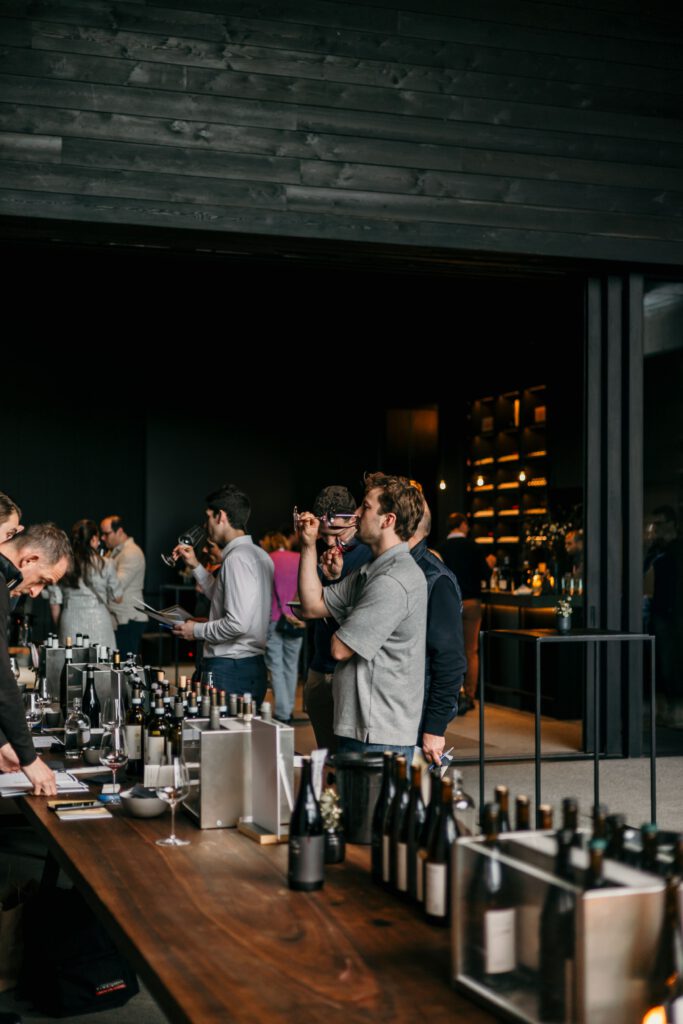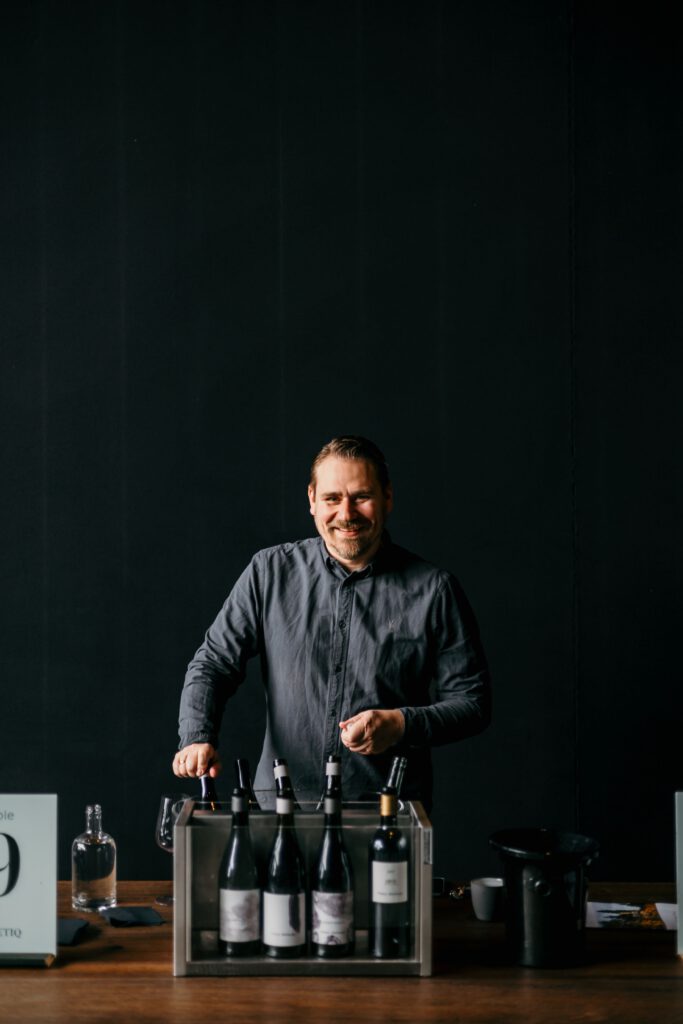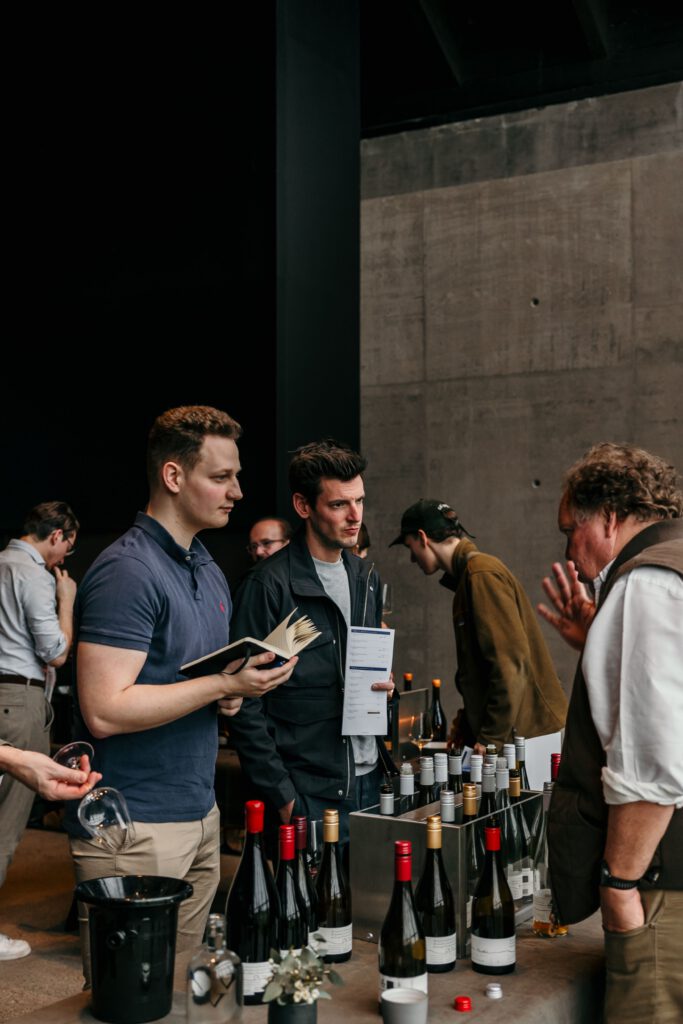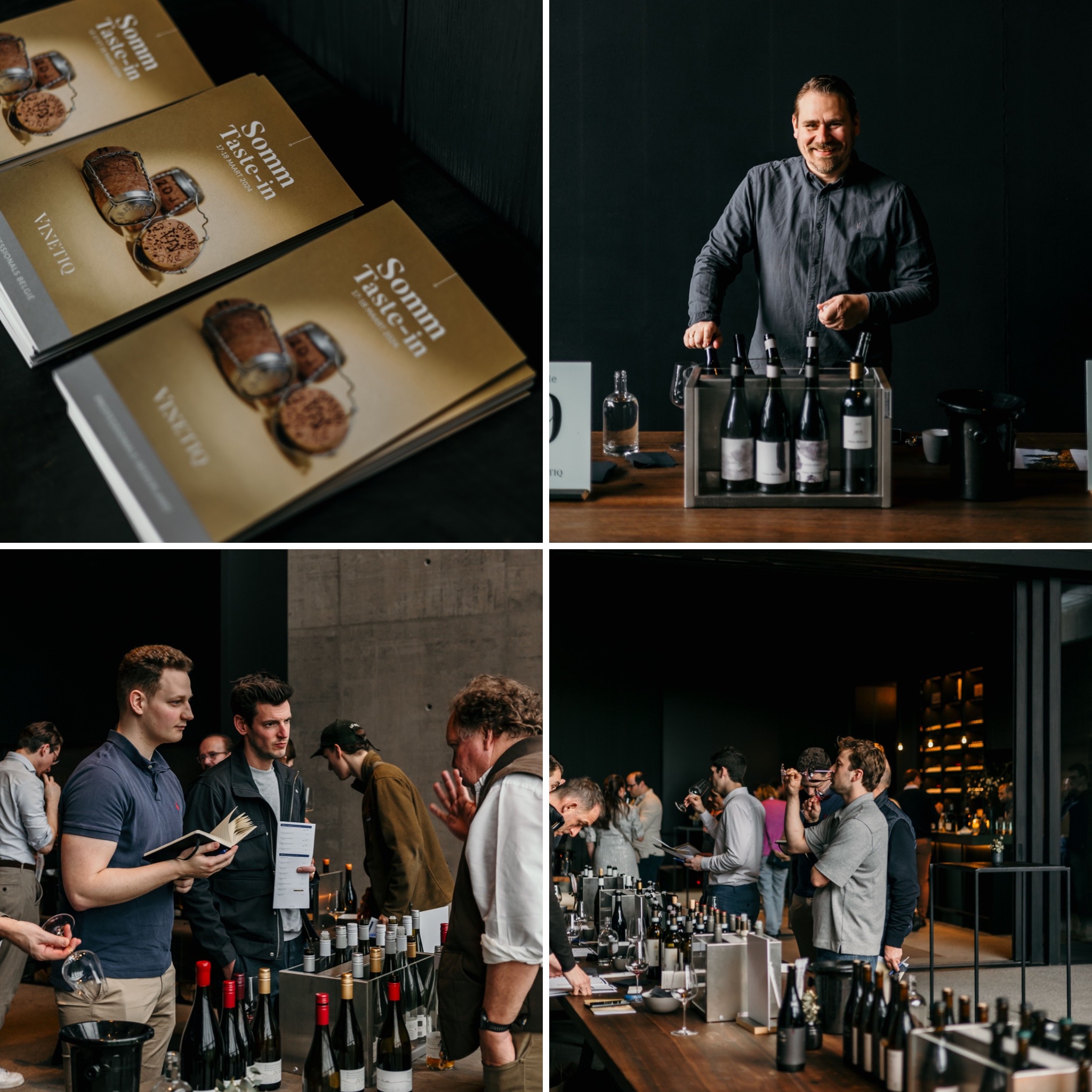Chill Elegance: Discovering the Diversity of Cooler-Climate Wines with Vinetiq.
As spring has arrived, with the days getting sunnier and longer, the mood of the many wine drinkers shifts towards elegant cooler-climate wines, perfectly encompassed by Vinetiq’s specialized range of imports. From Canada to France and from Austria to the United States, this tasting virtually highlighted all places where ‘cool climate’ wines are made, wines classically defined by pure fruit flavours, fresh acidity, and great complexity and longevity.
These styles of wine are often found in relatively cooler winegrowing regions, either at higher altitudes or latitudes, where grapes retain their acidity well and develop complex aromas due to long growing seasons. As an added bonus, the wines from these types of climates often have lower alcohol.
All in all, hosted at their home base of Wijndomein Valke Vleug in Belgium with over 120 wines opened for tasting, Vinetiq once again showed how brilliantly it performs in its niche of cooler climate wines – with virtually all wines showing great freshness and typicity, and above all excellent value. Below we highlighted three of our favorite wineries in attendance, along with some various other wines that stood out to us due to their character, price, or general style.

Norman Hardie Wines
Prince Edward County (commonly referred to as the County) is one of the coldest wine-growing regions in Canada. Here, temperatures are on average 2°C colder than the Niagara Peninsula, Canada’s principal wine-growing region. The County is surrounded on three sides by Lake Ontario, whose capacity to store summer heat extends the growing season far into autumn, making viticulture possible. The soils consist of stony limestone and clay, comparable to Burgundy. This allows for elegant and fresh expressions of Pinot Noir, Chardonnay, and even Cabernet Franc – all in relatively French styles, but with a bit more fruit intensity due to the higher hours of sunshine achieved.
However, not all is ideal in the County. Due to the extreme winter freezes that often go up to minus 25°C, the vines regularly have to be ‘hilled up’ in the winter for them to survive, meaning they are buried below a layer of dirt to prevent the extreme temperatures from harming them. This process adds around 10% to the cost of production, which combined with the scarce and expensive labor, along with the grape varieties and clones planted being naturally lower yielding, means high costs of production. Despite this, even here relative value can be found, with Norman Hardie Wines being a prime example.
As of today, Norman Hardie farms roughly 15 hectares of vineyards in the County, and regularly buys fruit from Niagara growers. His focus is on Burgundian winemaking, having studied with Hubert Lamy in Burgundy, Bouchard Finlayson in the Hemel-en-Aarde Valley, and at Au Bon Climat in Santa Barbera. This experience, combined with meticulous sorting in the vineyard and hyper-attentive yet naturalist winemaking results in outstanding, classic wines, being reminiscent of Burgundy but still expressing the County. Oak is often used, but as with the greatest white Burgundies it is always seamlessly integrated, being firmly present but at the same time subtle and nuanced.
From some of the County’s best Pinot Noirs to a red cuvée specifically designed to go along with their wood-fired pizza (Cuvée Della Bosca), both very serious and more informal wine lovers can find plenty to love in the wines of Norman Hardie. A winery to keep watching with a ton of interesting stuff going on and new projects, such as world-first bottlings of County Cabernet Franc and sparkling wines that are currently waiting to be released in about four years of time. Judging by the tasting every single wine is worth seeking out, with great price to quality ratios across the range.
We recently released an article about a Masterclass with Norman Hardie. To learn more about the man, his winery and the wines click here.

2019 Norman Hardie Wines – County Chardonnay
Signature Chardonnay from Prince Edward County’s rocky, limestone soils. The cool climate shines through with a fresh citrus profile on the nose, but with good ripeness. Lemon, lime, peach, ripe pear and floral notes come through with vanilla and clove due to the usage of oak barrels. Struck match and flint aromas give additional tension to the wine. Nuanced hints of butterscotch are also present, hinting at some development in bottle. Great minerality and refreshing acidity. Still stands strong after three years in bottle.
We reward this wine with a 92-point DWA score. Drink 2024-2029.
2020 Norman Hardie Wines – Chardonnay Cuvée des Amis
Compared to the regular County Chardonnay, this wine has seen longer aging of roughly a year in barrel (partly new), and then an additional year in a large, horizontally-shaped stainless-steel tank, maximizing lees contact. Very expressive nose with intense nougat and toasty notes, almost smelling like a vintage Champagne. Ripe yellow fruit, apricot, lemon and peach. High acidity gives freshness and balances the richness of the lees and oak influence. Great length and wonderful depth. Very intense and different, one to look out for. Bottled unfined and unfiltered.
We reward this wine with a 95-point DWA score. Drink 2024-2035.
2021 Norman Hardie Wines – County Pinot Noir
Pale ruby colour. Extremely elegant but with good structure. The aromatics here are very pure and give a fresh red fruit profile of strawberry, cranberry and fresh pomegranate, with additional rose and clove notes adding further complexity. Some whole bunch notes of stem and spice emerge with additional time in the glass. Quite high acidity, but with enough depth of flavor to keep the wine nicely balanced. Floral and elegant, rather like a Volnay. Detailed tannins give structure and longevity. Light in alcohol. All in all, a very representative wine that fully speaks of its origin. Great effort. Will improve with some more time in bottle.
We reward this wine with a 93-point DWA score. Drink 2024-2032.
2020 Norman Hardie Wines – Cabernet Franc
The fruit for this wine was sourced from the Niagara Peninsula, where the climate is a bit warmer and more clay is present in the soil. This in turns gives wines with a bit more density and ripeness than those from Prince Edward County – all while retaining the signature elegant, cool-climate style. Lovely aromatic intensity, with fresh red fruit, floral violet notes, and a nuanced leafy note. More structured on the palate, with chalky, well-managed tannins and blueberry fruit. Elegant style, almost like a Chinon or Bourgueil wine.
We reward this wine with a 93-point DWA score. Drink 2024-2030.
Weingut Markus Altenburger
Situated in Jois, a small village in the Leithaberg DAC north of Austria’s Neusiedlersee, Markus Altenburger makes some of the country’s most profound and pure bottlings of Blaufränkisch, aided by the region’s limestone and schist soils. This part of Austria used to be partly submerged into the sea, explaining the limestone found at mid-slope vineyards, with the higher altitudes (where the sea did not reach) consisting of slate and schist. These types of soils, combined with the cooling influence of cold air descending down the wooded slopes of the Leithaberg mountains at night, provide ideal conditions for making clean, terroir-driven wines, showcasing limestone salinity and exceptional purity.
In his youth, Markus loved the taste of Neuburger grapes, which fueled his passion for natural winemaking as he did not find this pure, natural grape taste in Austria’s wines of the early 2000s. Hence, the wine at this estate is made in the vineyard, with Markus in the cellar only trying not to disturb the natural balance the vineyard has given him. Concrete eggs and large, old oak is used to give the wines subtle oxygenation, but not to impart any strong oak flavor and tannins. From his entry-level vom Kalk bottling to the single-vineyard Gritschenberg, all the wines are great examples of the elegance both natural winemaking and the Blaufränkisch grape can express. Despite the focus on Blaufränkisch outstanding examples of Chardonnay and Grüner Veltliner are also made, and perhaps above all in originality and versatility, an orange wine of Neuburger is made, with delicious drinkability but also pure fruit and complexity.

2022 Markus Altenburger – Blaufränkisch vom Kalk
Entry-level Blaufränkisch from a mix of limestone, schist, and richer loam soils. Elegant winemaking with a focus on the purity of the fruit. Pale colour, fresh raspberry, plum, blackberry, and floral violet notes. Vibrant, with crunchy tannins and aging in old, large oak adding a bit of texture. Fresh acidity and pure fruit showcase the house style. Lovely introduction to Markus’ range of wines.
We reward this wine with a 88-point DWA score. Drink 2024-2027.
2018 Markus Altenburger – Blaufränkisch Gritschenberg
From the single vineyard of Gritschenberg, located in the commune of Jois. Limestone dominates here, giving a saltier expression of Blaufränkisch, with additional emphasis on structure and acidity. Significantly deeper colour than the vom Kalk bottling. Pronounced aromatics, showing forest fruit, tobacco, leather, violet, bramble, and smoky minerality. 25% whole bunches were used in combination with two years of aging in old, large oak, allowing for an expression of Blaufränkisch that combines the elegance and power of the variety. Only the older vines are used for this bottling, giving extra concentration and depth. Structured and tannic, but by no means coarse. Very detailed and pure fruit, giving exceptional subtleness. Unfined and unfiltered. Perfectly drinking now, but will keep for decades to come.
We reward this wine with a 94-point DWA score. Drink 2024-2048.
2022 Markus Altenburger – Neuburger Betont
Orange wine made from the grape variety that sparked Markus’ love for winemaking. The Neuburger grapes were macerated in the juice for roughly five days, giving a subtle orange colour along with a slight tannic grip to the wine. Quite aromatic, with notes of orange blossom, yellow pear, marmalade, peach and wet stone. Structured but with good acidity to balance the grip of the wine. According to Markus this variety is one to watch for the future as it thrives on the region’s limestone soils and is drought-resistant. Climate change-proof, delicious and complex, paving a way for a possible future for the white wines of Leithaberg.
We reward this wine with a 90-point DWA score. Drink 2024-2026.
Champagne Marie Demets
Our last highlighted winery is Champagne Marie Demets, a small family-owned estate founded in 1986, farming roughly 10 hectares of vines along the Seine valley in the Côtes de Bar. The Côtes de Bar is the most southerly sub-region of Champagne, with a strong reputation for relatively fuller-bodied Pinot Noir. This is due to the region’s soils, consisting of a fair bit of clay besides the traditional limestone the more northerly sub-regions such as the Côtes de Blancs are known for. This combination of clay and limestone is the same as is found in Chablis, namely Kimmeridgian marl. Compared to pure limestone, wines from marl tend to be relatively fuller, fruitier wines due to the clay content of soils – perfectly shown by the Brut NV bottling of this house.
Anyway, back to the grower. As of 2017, the same year winemaker Pierre Demet’s wife Mathilde joined the winery, a new philosophy was adopted, intending to focus on the vineyard and letting the quality of the fruit speak for itself. Ever since, the wines are characterized by crystal-clear purity while still retaining the region’s signature clay influence on the wines, giving a bit more fruit and roundness. Higher end wines are matured in large, 500-litre barrels before the second fermentation, giving more density and texture to the fruit while still retaining elegance and purity – aided by older vines giving lower yields of more concentrated juice.
Recent developments at the house include a new plot that is farmed which will be turned into a Blanc des Noirs wine, offering an interesting comparison to the single vineyard wines La Forêt and Les Fins bottlings, both being Blanc des Blancs wines. Furthermore, Pierre recently started a reserve perpétuelle intended for the Brut NV bottling, adding further depth and complexity to their entry-level wines. The reserve perpétuelle is a system of vats with multiple vintages stored in it from which a set amount is drawn each year, which is replenished with the new vintage. This gives increasing complexity with the years, as more vintages are represented in the vats.
Altogether, a grower to be on the lookout for with lots of exciting things going on, and above all, beautiful, classic expressions of grower Champagne from the Côtes de Bar. The friendly smile Pierre and Mathilde greet you with when approaching to try their wines says it all.

Champagne Marie Demets – ‘Tradition’ Blanc de Noirs Brut NV
House style, being 100% Pinot Noir from the Côtes de Bar. Over half of the wine is reserve wine from the two preceding vintages, giving depth and complexity. Medium-bodied and relatively round, showing ripe red apple, lemon, smoke and toast, but with ample acidity to keep the wine fresh. Very classic Côtes de Bar style and a lovely introduction to the house. Good length. 15 months on the lees and bottled with 4 grams of residual sugar. Will be exciting to see this style evolve as the reserve perpétuelle is introduced in the coming years.
We reward this wine with a 88-point DWA score. Drink 2024-2025.
2018 Champagne Marie Demets – ‘La Forêt’ Blanc de Blancs Extra Brut Millésimé
100% Chardonnay from the La Forêt single vineyard in their home town of Gyé-sur-Seine. This vineyard contains also a large portion of pure limestone besides the famous Kimmeridgian marl, giving extra freshness and structure to the wine. This type of soil combined with Chardonnay being planted gives a very classic Champagne style, rather resembling a Côte des Blancs style, even in the hot vintage of 2018. Tight, mineral, lemon-lime expression, with rich nougat and toast flavours from the longer lees aging in bottle. The vinification took place in 500-litre barrels, giving additional richness to balance the piercing freshness of the wine. Very intense and refined, showing once again why Champagne is the benchmark in the world of sparkling wine. Very long finish. Will improve in bottle and smooth out over time. Vines planted in 1988, bottled with 1.5 grams of dosage. Great stuff.
We reward this wine with a 94-point score. Drink 2026-2033.
2018 Champagne Marie Demets – ‘Les Fins’ Blanc de Blancs Extra Brut Millésimé
The richer and fuller counterpart of the La Forêt wine, made with the same grape variety and same vinification techniques. The difference is that this plot contains more clay, giving a richer, rounder expression of Champagne. Intense aromatics, with ripe peach, lemon, lime, hazelnut and toast. Broader palate, with greater richness and generosity. A tad less acidity, but with intense fruit concentration to balance the wine. Drink this now, and forget about the La Forêt bottling for a couple of years. Vines planted in 2000 in the commune of Neuville-sur-Seine, bottled with 1.5 grams of dosage.
We reward this wine with a 93-point DWA score. Drink 2024-2031.
Other standout Wines
Apart from the great wines highlighted above, several other wines also caught our attention and were worth talking about. All imported by Vinetiq, and highly recommended by us.
2014 Weingut Clemens Busch – Riesling Falkenlay Auslese
Half bottle. Produced by Clemens Busch, rom the Falkenlay plot in the Marienburg Grosse Lage, named after the falcons that used to nest in the rocky outcrops on this steep, grey slate vineyard. Barely showing any signs of its eight years in half-bottle. Floral, honeyed pineapple and peach combine freshness with elegance. High acidity cuts through the intense sweetness, giving layers of complexity. Very long finish. Will age for decades more without any trouble, if you have the patience. Already delicious and just starting to sing.
We reward this wine with a 95-point DWA score. Drink 2024-2054.
2020 Stratus Vineyards – Riesling Icewine
Half bottle. Icewine produced by Stratus Vineyards, from the Niagara Peninsula where consistent yearly frosts give a steady supply of Icewine, which is legally required to be harvested at -8° C. Rather high alcohol for an Icewine with 14%, but it carries it without any trouble. Very pure fruit and honeyed flavours, with candied peach, mango, ripe pineapple, apricot, papaya, and cinnamon. The intense, honeyed fruit and searing acidity complement each other beautifully. Vinified in stainless steel to preserve its delicacy and vibrancy. Will age for a long time, but the pure, candied fruit flavours make it already hard to resist.
We reward this wine with a 96-point DWA score. Drink 2024-2040.
2017 Château Pauqué – Sous La Roche-Rue Riesling
Crafted by Abi Duhr, one of Luxemburg’s leading winemakers. From steep slopes along the Mosel River, not unlike the neighboring Saar region in Germany, but with limestone and chalk instead of Germany’s slate. Very elegant nose of peach, lime, wet stone, orange blossom and jasmine. Has a certain ripeness to it, with honeyed aromas also being present. Linear and fresh but with a solid backbone and a certain exotic touch. Unique expression of Riesling, worth seeking out.
We reward this wine with a 90-point DWA score. Drink 2024-2030.
2019 Cristom Vineyards – Mt. Jefferson Cuvée Pinot Noir
Pinot Noir from Oregon’s famous Willamette Valley, where poor volcanic loess soils create some of America’s finest Pinot Noirs, led by pioneers such as Eyrie Vineyards. This Pinot Noir by Cristom Vineyards has seen a good proportion of whole bunch fermentation, giving fresh red fruit, a floral lift, and spicy, clove complexity. Full-bodied with good structure, helped in part by the usage of new oak barrels. Great fruit and tannin quality. Still young, will improve with age.
We reward this wine with a 93-point DWA score. Drink 2024-2039.

Reflecting on a Day of Distinctive Cool Climate Wines with Vinetiq
To conclude, we look back on a great day of tasting and getting to know the unique producers Vinetiq brought to the table. Many of the wines tasted showed great typicity and were benchmarks for their region, while also being ambassadors of the current very high quality of cool climate wines in general. We will be on the lookout for more of their imports in the future.
This article is written by our own Martin Bronkhorst. We would like to thank the team of Vinetiq for the invitation and their hospitality, and of course all wineries for their time and great wines.

